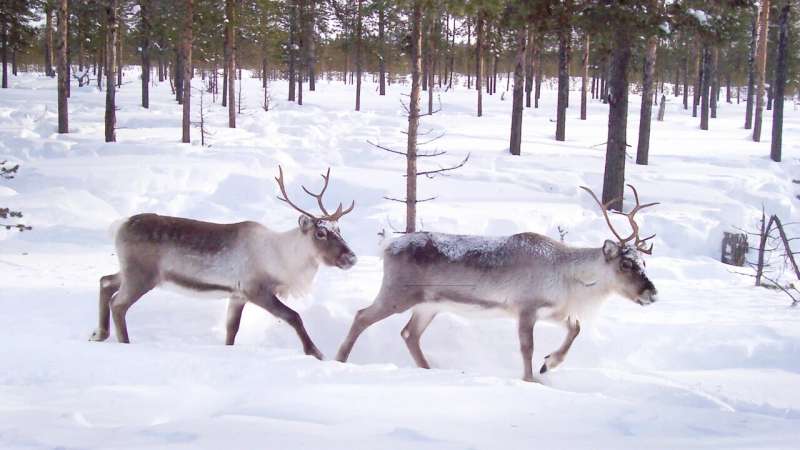This article has been reviewed according to Science X's editorial process and policies. Editors have highlighted the following attributes while ensuring the content's credibility:
fact-checked
peer-reviewed publication
trusted source
proofread
Exotic tree species in the forest mean loss of grazing land for reindeer

Semi-domesticated reindeer avoid winter habitats with exotic lodgepole pine (Pinus contorta), introduced from Northern America. Reduced food supply and dense stands probably contribute to the reindeers' avoidance behavior of areas with tall P. contorta-trees. This is reported by researchers from Umeå University and the Swedish University of Agriculture, SLU in the journal Forest Ecology and Management.
P. contorta [TH1] has been planted mainly in northern Sweden since the 1960s, as it is expected to grow faster than the native pine (P. sylvestris). However, it has been reported that both plants and animals can be negatively affected in stands with P. contorta. Reindeer herders have also reported that reindeer do not find enough forage in these stands, and that these stands can be an obstacle for their movements. Based on the reindeer herders' observations, the research group analyzed the reindeer's habitat selection in detail.
"Using GPS data from reindeer collected by reindeer herders in the herding district Vilhelmina norra, we analyzed how the reindeer moved in the landscape during three different winters. We investigated which areas the reindeer preferred to stay in and which they avoided. We were interested in investigating whether we could find the same behavioral pattern observed by reindeer herders," says Tim Horstkotte, research engineer at the Department of Ecology and Environmental Science (EMG) at Umeå University.
Using data on the reindeer's movement patterns over three winters, the research group investigated the reindeer's behavior on the herding district's winter pastures. They also investigated whether the amount of terricolous lichen differs in different forest types, as well as on which soil types the box pine grows.
Results consistent with observations
The study shows that tree height was an important factor in how much more reindeer avoid stands with P. contorta compared to stands with our native pine.
"If the P. contorta trees were higher than 3 meters, our results show that the reindeer avoided these areas relative to other forest types. Where the P. contorta trees were lower, the reindeer's choice of forest type was not affected—regardless of whether there was P. contorta in the stand or not," says Tim Horstkotte.
"It is also important to highlight that we also saw that there was less terricolous lichens in the P. contorta stands, even though P. contorta is often planted on dry land that is actually favorable for these lichens. This may indicate that planting P. contorta affects lichen occurrence negatively, even if the soil conditions should be favorable."
P. contorta is a challenge for many
Jörgen Sjögren, researcher at SLU in Umeå and who also participated in the study, emphasizes the importance of this type of investigations:
"Today, P. contorta in Sweden is planted on an area that covers just over 600,000 hectares. For having such a huge area with a tree species that does not originate on this side of the Atlantic, we know surprisingly little about the ecological consequences. This study contributes significantly to the state of knowledge."
The researchers point out that planting P. contorta on land that is suitable for terricolous lichens contributes to a reduction in winter grazing for the reindeer. Within the entire reindeer husbandry area in Sweden, access to winter pastures with a high presence of terricolous lichens is a bottleneck. This, in combination with other external pressures on reindeer herding, including climate change, makes the conditions for reindeer herding more difficult.
More information: Tim Horstkotte et al, Semi-domesticated reindeer avoid winter habitats with exotic tree species Pinus contorta, Forest Ecology and Management (2023). DOI: 10.1016/j.foreco.2023.121062
Journal information: Forest Ecology and Management
Provided by Umea University



















